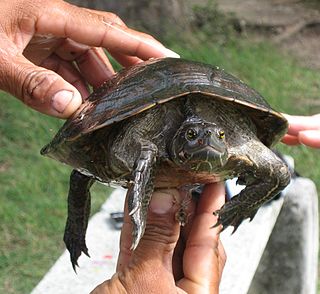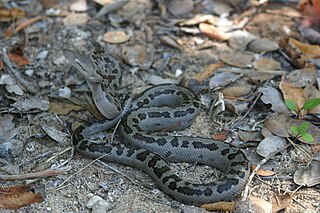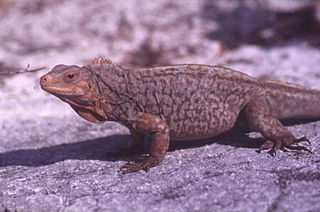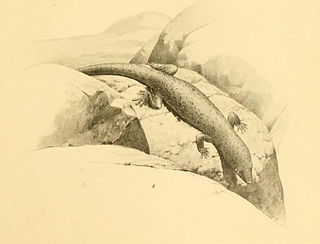 W
WCyclura rileyi nuchalis, commonly known as the Acklins ground iguana or Watling Island iguana, is an endangered subspecies of lizard of the genus Cyclura it is one of three subspecific forms of Cyclura rileyi in the family Iguanidae.
 W
WThe brown anole, also known commonly as the Bahaman anole or De la Sagra's anole, is a species of lizard in the family Dactyloidae. The species is native to Cuba and the Bahamas. It has been widely introduced elsewhere, by being sold as a pet lizard, and is now found in Florida and as far north in the United States as southern Georgia, Texas, Louisiana, Mississippi, Alabama, Hawaii, and Southern California. It has also been introduced to other Caribbean islands and Taiwan in Asia.
 W
WAnolis smaragdinus, also known as the Bahamian green anole, is a species of anole lizard in the family Dactyloidae.
 W
WThe Central Antillean slider, is a species of turtle in the family Emydidae. The species is found on three islands in the West Indies: Hispaniola, Great Inagua, and Puerto Rico.
 W
WChilabothrus chrysogaster, commonly known as the Turks Island boa or the Southern Bahamas boa, is a species of snake found in the Southern Bahamas and the Turks and Caicos Islands. Local names include rainbow boa, Bahamas cat boa, rainbow snake, and fowl snake. Like all boids, it is not a venomous species.
 W
WChilabothrus exsul is a nonvenomous boa species found in the Bahamas. No subspecies are currently recognized.
 W
WCope's least gecko is a species of lizard in the family Sphaerodactylidae. The species is endemic to the West Indies.
 W
WThe northern Bahamian rock iguana is a species of lizard of the genus Cyclura that is found on Andros Island and the Exuma islands in the Bahamas. Its status on the IUCN Red List is vulnerable, with a wild population of less than 5,000 animals.
 W
WCyclura cychlura figginsi, known by the common name of guana and sometimes called the Exuma Island iguana in the international literature, is a subspecies of the northern rock iguana, C. cychlura, that is found on the Exuma island chain in the Bahamas with an estimated wild population of 1,300 animals in 2004, it has been listed on the IUCN Red List as critically endangered.
 W
WThe Allen Cays rock iguana or Allen Cays iguana is a subspecies of the northern Bahamian rock iguana that is found on Allen's Cay and adjacent islands in the Bahamas. Its status in the IUCN Red List is critically endangered, with an estimated wild population of 482–632 animals.
 W
WCyclura rileyi, commonly known as the Bahamian rock iguana or the San Salvador rock iguana, is a critically endangered species of lizard in the family Iguanidae. The species is native to three island groups in the Bahamas, and is in decline due to habitat encroachment by human development and predation by feral dogs and cats. There are three subspecies: the Acklins ground iguana, the White Cay iguana, and the nominotypical subspecies.
 W
WCyclura rileyi cristata, commonly known as the White Cay iguana or Sandy Cay rock iguana, is a critically endangered subspecies of lizard of the genus Cyclura native to a single cay in the Bahamas: White Cay located in the Southern Exumas.
 W
WThe Jamaican slider also known as the Cat Island slider is a species of fresh water turtle in the family Emydidae. It is found in the Bahamas and Jamaica. As it is not currently found on any of the other surrounding islands in the region it is assumed that the Jamaican slider was introduced from one of these countries to the other. Even though the popular theory was that these turtles originated from Jamaica, current geological evidence may suggest that they were in the Bahamas long before the native Indians first went to the Bahama islands. There is also evidence from archeological sites on San Salvador that the native Indians ate these turtles and transplanted them around the West Indies.
 W
WLeiocephalus carinatus, commonly known as the northern curly-tailed lizard, is a species of lizard in the family Leiocephalidae.
 W
WThe northern Bahamian rock iguana is a species of lizard of the genus Cyclura that is found on Andros Island and the Exuma islands in the Bahamas. Its status on the IUCN Red List is vulnerable, with a wild population of less than 5,000 animals.
 W
WSphaerodactylus corticola, also known commonly as the central Bahamas sphaero or the Rum Cay least gecko, is a species of lizard in the family Sphaerodactylidae. The species is endemic to the Bahamas.
 W
WSphaerodactylus nigropunctatus, also known as the black-spotted least gecko or three-banded sphaero, is a species of lizard in the family Sphaerodactylidae. It is found in the Bahamas and Cuba.
 W
WSphaerodactylus notatus, also known as the Florida reef gecko or brown-speckled sphaero, is a small species of gecko native to the Caribbean.